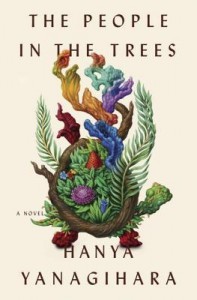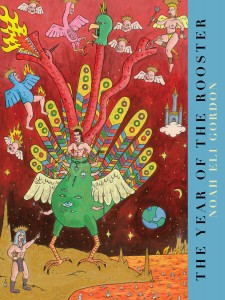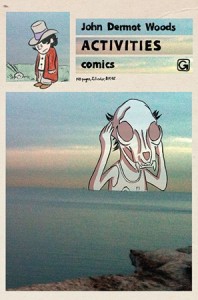Book Reviews, 10/2013
This issue
Hanya Yanagihara, The People in the Trees
Noah Eli Gordon, The Year of the Rooster
John Dermot Woods, Activities
Hanya Yanagihara | The People in the Trees
Doubleday, 2013
by Brian Gebhart
When explorers ventured into unknown territory—in the days when there was such a thing—they often projected onto the land and its people their own desires and fears, whatever secret terrors and deep-seated lusts they brought with them. This observation appears prominently in works of the past half century, but it’s long been a staple of Western literature. One can find it in Heart of Darkness, of course, but go back to the beginnings of the English novel—with Robinson Crusoe and Gulliver’s Travels—and you’ll find it there, too. Go further into the past, and you’ll find it even in Shakespeare. So it should come as no surprise that Hanya Yanagihara lays the foundation for her impressive debut novel, in which American scientists seek to uncover the mysteries of an un-contacted tribe, with an epigraph from The Tempest. She quotes Prospero’s description of Caliban as “A devil, a born devil, on whose nature/ Nurture can never stick,” and his enraged vow to “plague them all,/ Even to roaring.”
The presumed savagery of indigenous peoples may explain the fear, but what about the desire? The first Europeans to explore (and pillage, and conquer) the Americas came in search of both fortune and fantasy. Coronado yearned for gold, Ponce de Leon for the Fountain of Youth. And while these men often achieved great fortune, causing their names to live on far beyond their deaths, they always failed to conquer that last, most absolute frontier: their own mortality.
In The People in the Trees, Yanagihara brings this most coveted fantasy to life. In 1950, a young doctor, Norton Perina, accompanies two anthropologists to the fictional Micronesian island of Ivu’ivu. There, the team meets a small, remote tribe whose people have discovered how to extend their lives far beyond a normal span by consuming the flesh of a rare turtle. However, this blessing comes with an equally momentous curse. The Ivu’ivuans can live for centuries, their bodies as robust and healthy as they were when middle-aged, but their minds progressively deteriorate.
Still, Perina’s discovery touches off a frantic search for the source of this miracle, and as scientists and pharmaceutical companies descend on Ivu’ivu, the unique turtle species is quickly driven to extinction. The island’s inhabitants—and those of the two neighboring islands that, together with Ivu’ivu, compose this tiny nation—are subject to a familiar fate. While this is happening, Perina begins to adopt Ivu’ivuan children, often orphans who are pressed upon him by the island’s impoverished people. Over a period of two decades, the unmarried Perina brings home 43 children to live with him in his Maryland home, with only himself and a housekeeper to care for them.
Yanagihara divulges most of this information via two newspaper articles that serve as the novel’s opening, a bold narrative choice that sometimes deprives the story of suspense. But what’s more striking is the occasion of the articles: in 1995, the 71-year-old Perina, now a Nobel Laureate, is charged with several counts of rape and sexual assault, charges that originate from one of his adopted children. The other children are removed from his care, and two years later he is convicted and sentenced to prison.
While in prison, Perina begins to write his memoirs, sending them in the form of letters to a former colleague, Dr. Ronald Kubodera, who has compiled, edited, and annotated them. This text, “The Memoirs of A. Norton Perina,” forms the main body of the novel. In a preface that cannot help but call to mind Nabokov’s forward to Lolita, Kubodera defends Perina with an unsettling vigor, insisting that even were the accusations to prove true, Perina’s great contributions to science should outweigh his allegedly monstrous acts. So one must read the book with one skeptical eye on its narrator, who is trying to save his reputation, and another on its editor, whose sycophantic devotion to Perina borders on obsession.
It may seem that Yanagihara has given away too much at the start, that we’ve been handed a novel’s worth of revelations in two pages of dry journalistic prose. And it’s true that the beginning lags a bit, as Perina recounts his childhood and college years. But once he arrives on Ivu’ivu, the story enters new and fantastic territory. Yanagihara’s descriptions of the island and its people are beautifully rendered, and Perina’s narrative voice is always compelling. Even in his own accounting, Perina is often a boor and a bully, trampling social customs, scientific ethics, and the wellbeing of those around him in his single-minded pursuit of discovery. And though he often avoids uncomfortable subjects, we see much that he ignores or elides.
Though Perina mourns the fate of the islanders, he reserves his greatest sorrow for his own failures as a scientist. Telomerase, the enzyme that determines how DNA is replaced during cell division—and therefore controls aging—is only discovered after the turtles of Ivu’ivu are extinct. “To be a scientist,” he writes, “is to learn to live all one’s life with questions that will never be answered, with the knowledge that one was too early or too late…” When it becomes clear that Perina and his fellow scientists have failed, that their greed for discovery (and the profit and glory that would have accompanied it) have destroyed any hope of unlocking this great secret, Perina spends several pages keening over the loss. “Shall I tell you of the recriminations, the desperation, the bemoaning of years wasted, the millions of dollars spent, the agony of knowing how close we were to eternal life and how it once again eluded us, all dreams of godliness turned into water glugging down a wide-mouthed drain?” Give Perina credit for this much: at least he’s honest enough to admit that “godliness” is what he was after.
Late in the book, Perina turns away from the subject of his career and focuses on his adopted children. Here, too, he casts himself as a sort of benevolent deity, granting these outcasts great gifts of safety and opportunity while asking nothing in return. But though Perina wields godlike power, he refuses to acknowledge its breadth and capriciousness. It’s an important blind spot, one that has disastrous consequences. And as the rest of this bold, imaginative, troubling novel suggests, it’s a blind spot he shares with much of the human race.
Noah Eli Gordon | The Year of the Rooster
Ahsahta, 2013
by Kevin O’Rourke
Noah Eli Gordon is a major poet, and his new book The Year of the Rooster is an important, serious book worthy of serious consideration. TYOTR is not, however, an easy book to read, made up as it is of abstruse poems without obvious speakers in a variety of shifting forms. Oh, and one of the book’s poems is 72 pages long.
Comprised of four sections, the book is bookended by two mirrored sections of 14 poems that go from 16 lines to one line and then back, with titles like “A Proposal as Arbitrary as the Phenomena it Purports to Eliminate” and “The Glue Holds the Gutters In. The Rhetoric’s a Loose-Leaf Apprentice.” Meanwhile, the book’s core consists of two long poems: first the 72-page poem after which the collection is named and which seems to be loosely about a possibly transsexual Rooster character and travel and authorship, and another long piece, this one an ars poetica that ends in the sort of byzantine, neurotic prose that would make Gaddis proud.
Uninterested in traditional, poem-about-an-object-or-person poems, The Year of the Rooster is a difficult, abstract, conceptual book of poetry, and is at times confoundingly dense. Okay. So what? TYOTR is hardly the first abstract book of poetry to be published. And can’t poetry be difficult and conceptual? Well, it seems conceptual poetry (or experimental poetry, something TYOTR’s publisher Ahsahta “champions and promotes”) remains problematic for some. In his recently published essay, “Against Conceptualism,” Calvin Bedient notes that conceptual “poetry has rammed against poetry, saying, I’m the honest stuff, the real poetry, in not being poetry at all.” Though I find his essay’s argument interesting — he argues in favor of emotion in poetry, and against “emotionally neutral methods” — the last half of the above quote makes me nervous, particularly “real poetry” stuff, insofar as it implies that there is such a thing as real poetry.
These sorts of arguments were hauled out often after World War II when confused visual art critics were forced to contemplate shows by abstract expressionists like Jackson Pollock. After Pollock showed his drip paintings for the first time in 1948, the New Yorker’s art critic Robert Coates said the work seemed to be “mere unorganized explosions of random energy, and therefore meaningless.” Ignoring Coates’ implication that unorganized things are meaningless, why, in the year of our lord 2013, are we still hearing similar criticisms of literary work? Haven’t we by now taken to heart what Wallace Stevens wrote in his 1947 poem “Man Carrying Thing”: “The poem must resist the intelligence /almost successfully…”
The issue, I suspect, is the ultimate reason writing came about — to convey information — and our inability to get past that. If I write, “I have a bomb, give me your money” on a piece of paper and hand it to a bank teller, that teller will certainly understand my wishes. Likewise, clerical information inscribed on four thousand year-old Sumerian tablets still makes sense today: though the script has changed, taxes, along with death, remain one of the few things in the world upon which we may rely.
For its part, poetry turns this facile explanation of what writing does/what it is intended for on its head, as poems do not necessarily exist to convey information. Conceptual/experimental poetry further divorces writing from information-conveyance, using language to do all manner of things that lists of goods or news articles or poetry reviews don’t attempt to do, such as embodying ideas, or intentionally confounding and challenging readers, often subverting the rules of grammar and using form in striking ways to do so. Take this section from TYOTR’s lengthy central title poem:
Gimme pelican architecture
the shape of the forest not the forest
happy ink’s unabridging machine
a bit of ivy slowing a yellow wall
Things happen in lines, windows, flakes
You pluck feathers every morning
Other people have more diamonds, bigger diamonds
Is that something Roo would wear?
So yes, TYOTR asks much of its reader, often requiring extraordinarily close reading. As I found over the last several weeks, one does not easily curl up with TYOTR in bed at night. This is not a beach book. Reading TYOTR can induce fugue-like states of distracted half-reading wherein one’s mind both wanders and attempts to make sense of what one is reading, which attempt leads to further wandering.
At times, TYOTR’s insistent abstraction (which do employ “emotionally neutral methods”) reinforced some of my skepticism about poetry of this sort. For example, the collection’s title poem sprawls tremendously, and like most big sprawling works of art, is a bit bloated. For example, the poem/section of the title poem that appears on page 71 is thirteen lines of “—cock-a-doodle-doo!— ” followed by, “it’s Roo’s sonnet for you.” It can be a difficult book to enter into and make sense of; even when the first person does appear, it never seems to signify that the poem in which it appears is interested in disclosure.
But for every cock-a-doodle-doo page, where the poet’s project seems to get the better of him, there are many more that are tremendously engaging, and yes, affecting. For example, these lines from the title poem are some of my favorite in the collection:
The first painting
you’d ever done
is the best you’ll do
not because you didn’t
know what it was
that you were doing
but because you didn’t
know what it was
that you weren’t
And at the risk of quoting at too great a length, here is the last sentence of “The Next Year: Did You Drop This Word,” the piece that immediately follows “The Year of the Rooster” and which Gordon acknowledges is its postscript. I remember reading this poem a few months ago, before I’d read the full book, and feeling as excited about it as I have any book of poetry. Since then, nothing’s changed. The Year of the Rooster is a challenging, thrilling book.
And once there, once windows have been shuttered, doors locked, every light
dimmed, once the now deserted streets at the center of this place seem in
their desolation to be baring the collective teeth from each absent face in
your general direction, & the banner, now beaten threadbare, trails like the
softest of shackles behind you, who is to say if it was worth it, if such
crossings & counter-crossings, so much chiasmic flurry, all the little fits &
starts that sent you off only to call you in again at the height of pleasure, who
is to say if all this babble, all these finely tuned phrases, all the words trued
with a watchmaker’s temperament, if all of it were worth trading for the act
from which it sprang, if you wouldn’t have been better off biting into the
apple without the burden of accounting for how you’d later abandon the core.
John Dermot Woods | Activities
Publishing Genius, 2013
by Quincy Rhoads
John Dermot Woods’ new book resides at the intersection of alternative literature and alternative comics. Strangely, this occurrence isn’t more frequent. Both genres seem to be depicting the same things: modern disconnection, the ecstasy of synesthetic perception, the uncomfortably surreal as externalization for raw emotions. And yet I know very few readers of comix who read alt lit and very few readers of alt lit who read comix, despite all the parallel aesthetics between them. Hopefully, Publishing Genius’s newest book will help redress this error and help narrow the gap between these two groups of readers.
The opening pages of Woods’ Activities contain a series of increasingly surreal sketches. Splash pages of the nightmarish are used to create unsettling juxtapositions, as when a grizzly bear on a tricycle sits opposite a page where a jockey in full riding regalia stands before a noose and a court judge flipping a coin, which then transitions to panels that switch orientation on the page. Women are caught naked in public, scrutinized by barking bulldogs and men eating peanuts. A man gnaws on a lead pipe with snot running down his nose, and in a separate splash page a father, home from work, cuts apart a fish with a butcher’s knife. The first twenty-three pages are nothing but these increasingly involved pages, causing the reader to grow unsettled right from the start.
John Dermot Woods’ art moves frenetically between lush colors that evoke Hergé by way of deviantART and scratched gray scale, from clean lines like those of Charles Schulz to the hastily penciled artwork of C.F. or Dash Shaw. The storytelling in Activities is equally evocative. Many of the stories in this collection share a sense of the world lacking connection as in the heart-rending strip about a couple’s last night together before one leaves in a rocket sent to the heavens.
Woods’ writing suggests some of the best voices of alt lit. “They Shared an Egg” could come directly out of a story collection by Amelia Gray, whereas “5 Cats” shares the same sort of overt metaphor as Shane Jones’ writing, and “Whistleblower” conjures a sense of uneasy pathos akin to the best of Blake Butler’s fiction.
Perhaps the most excitingly innovative element of this collection, though, is the section of “Recognitions” or found text used as the narration of several comic sequences. This wild experimentation is as delightfully befuddling as the first experience with the work of avante-garde pioneers Kathy Acker and William S. Burroughs. Luckily, Woods provides acknowledgements to all of the text sources, but this does not diminish the surprise to the reader when a scrap from a text message sent to Woods or a snippet from a radio broadcast can gains such gravitas in this new context.
John Dermot Woods’ work leaves readers with an exhilarating uneasiness that can be found in many 40-and-under writers. Activities serves as a great introduction to the rich worlds of experimentation in both underground comix and in alternative lit.



